Greenhouse Gas Emissions and Environmental Impact from Recycling the Organic Fraction of Solid Waste: Comparison of Different Treatment Schemes from a Life Cycle Perspective
Abstract
:1. Introduction
- (1)
- Exclusively aerobic treatment (COMP);
- (2)
- Integrated treatment based on non-inoculated SADB followed by post-composting of the digestate (SADBPC); and
- (3)
- Integrated treatment based on inoculated SADB followed by post-composting of the digestate (SADBPC-I).
2. Material and Methods
2.1. Pilot-Scale Apparatus and Run Procedure
2.2. Chemical Characterization
2.3. Life Cycle Analysis
2.3.1. Scope, Context Situation, and Functional Unit
2.3.2. Life Cycle Inventory Framework
2.3.3. Life Cycle Inventory (LCI) of Composting
2.3.4. LCI of Solid Anaerobic Digestion Batch (SADB) and post-composting (PC)
2.3.5. Selection of Impact Categories
3. Results and Discussion
3.1. Experimental Test
3.2. Life Cycle Assessment (LCA)
3.3. Sensitivity Analysis
4. Conclusions
Acknowledgments
Author Contributions
Conflicts of Interest
References
- Bolzonella, D.; Pavan, P.; Mace, S.; Cecchi, F. Dry anaerobic digestion of differently sorted organic municipal solid waste: A full-scale experience. Water Sci. Technol. 2006, 53, 23–32. [Google Scholar] [CrossRef] [PubMed]
- Di Maria, F.; Sordi, A.; Micale, C. Energy production from mechanical biological treatment and composting plants exploiting solid anaerobic digestion batch: An Italian case study. Energy Convers. Manag. 2012, 56, 112–120. [Google Scholar] [CrossRef]
- Beurskens, L.W.M.; Hekkenberg, M.; Vethman, P. ECN—Renewable Energy Projection as Published in the National Renewable Energy Action Plans of the European Members States. Available online: http://www.ecn.nl/docs/library/report/2010/e10069.pdf (accessed on 26 April 2016).
- Bouallagui, H.; Touhami, Y.; Ben Cheikh, R.; Hamdi, M. Bioreactor performance in anaerobic digestion of fruit and vegetable wastes. Process Biochem. 2005, 40, 989–995. [Google Scholar] [CrossRef]
- Lin, J.; Zuo, J.; Gan, L.; Li, P.; Liu, F.; Wang, K.; Chen, L.; Gan, H. Effects of mixture ration on anaerobic co-digestion with fruit and vegetable waste and food waste of China. J. Environ. Sci. 2011, 23, 1403–1408. [Google Scholar] [CrossRef]
- Scano, E.A.; Aquer, C.; Pistis, A.; Ortu, L.; Demontis, V.; Cocco, D. Biogas from anaerobic digestion of fruit and vegetable wastes: Experimental results on pilot-scale and preliminary performances evaluation of a full-scale power plant. Energy Convers. Manag. 2014, 77, 22–30. [Google Scholar] [CrossRef]
- ISPRA. Rapporto Rifiuti Urbani. Edizione 2016; Rapporti 251/2016; ISPRA: Rome, Italy, 2016; ISBN 978-88-448-0791-7. [Google Scholar]
- Vinot, M.; Perez, C.A.; Turm, P.; Maillo, A. Improvements in anaerobic digestion units and in pre-treatments performances beforehand. In Proceedings of the Third International Symposium on Energy from Biomass and Waste, Venice, Italy, 8–11 November 2010. [Google Scholar]
- Fricke, K.; Santen, H.; Wallmann, R. Comparison of selected aerobic and anaerobic procedures for MSW treatment. Waste Manag. 2005, 25, 799–810. [Google Scholar] [CrossRef] [PubMed]
- Rico, C.; Rico, J.L.; Tejero, I.; Munoz, N.; Gomex, B. Anaerobic digestion of the liquid fraction of dairy manure in pilot plant for biogas production: Residual methane yield of digestate. Waste Manag. 2011, 31, 2167–2173. [Google Scholar] [CrossRef] [PubMed]
- Ten Brummeler, E. Full scale experience with BIOCEL process. Water Sci. Technol. 2000, 41, 299–304. [Google Scholar] [PubMed]
- Di Maria, F.; Gigliotti, G.; Sordi, A.; Micale, C.; Zadra, C.; Massaccesi, L. Hybrid solid anaerobic digestion batch: Biomethane production and mass recovery from the organic fraction of solid waste. Waste Manag. Res. 2013, 31, 869–873. [Google Scholar] [CrossRef] [PubMed]
- Abdullahi, Y.A.; Akunna, J.C.; White, N.A.; Hallet, P.D.; Weatley, R. Investigating the effects of anaerobic and aerobic post-treatment on quality and stability of organic fraction of municipal solid waste as soil amendment. Bioresource Technol. 2008, 99, 8631–8636. [Google Scholar] [CrossRef] [PubMed]
- Di Maria, F.; Sordi, A.; Cirulli, G.; Gigliotti, G.; Massaccesi, L.; Cucina, M. Co-treatment of fruit and vegetable waste in sludge digesters. An analysis of the relationship among bio-methane generation, process stability and digestate phytotoxicity. Waste Manag. 2014, 34, 1603–1608. [Google Scholar] [CrossRef] [PubMed]
- Massaccesi, L.; Sordi, A.; Micale, C.; Cucina, M.; Zadra, C.; Di Maria, F.; Gigliotti, G. Chemical characterization of percolate and digestate during the hybrid solid anaerobic digestion batch process. Process Biochem. 2013, 48, 1361–1367. [Google Scholar] [CrossRef]
- Ponsa, S.; Gea, T.; Alerm, L.; Cerezo, J.; Sanchez, A. Comparison of aerobic and anaerobic stability indices through a MSW biological treatment process. Waste Manag. 2008, 28, 2735–2742. [Google Scholar] [CrossRef] [PubMed]
- Binner, E.; Smidt, E.; Tinter, J.; Bohm, K.; Lecher, P. How to enhance humidification during composting of separately collected biowaste: Impact of feedstock and processing. Waste Manag. Res. 2011, 29, 1153–1163. [Google Scholar] [CrossRef] [PubMed]
- Di Maria, F.; Segoloni, E.; Pezzolla, D. Solid anaerobic digestion batch of bio-waste as pre-treatment for improving amendment quality: The effect of inoculum recirculation. Waste Manag. 2016, 56, 106–112. [Google Scholar] [CrossRef] [PubMed]
- Smidt, E.; Tintner, J.; Bohm, K.; Binner, E. Transformation of biogenic waste materials through anaerobic digestion and subsequent composting of residues—A case study. Dyn. Soil Dyn. Plant 2011, 5, 63–69. [Google Scholar]
- Kohler, M.; Volsgen, F. Geomikrobiologie—Grundlagen und Anvendungen; Wiley-VCH: Weinheim, Germany, 1997. [Google Scholar]
- Linzner, R.; Mostbauer, P. Composting and its impact on climate change with regard to process engineering and compost application—A case study in Vienna. In Sardinia 2005, Proceedings of the Tenth International Waste Management and Landfill Symposium, S. Margherita di Pula—Cagliari, Sardinia, Italy, 3–7 October 2005; CISA Environmental Sanitary Engineering Centre: Sardinia, Italy, 2005. [Google Scholar]
- Blengini, G.A. Using LCA to evaluate impacts and resource conservation potential of composting: A case study of the Asti District in Italy. Resour. Conserv. Recycl. 2008, 52, 1373–1381. [Google Scholar] [CrossRef]
- Kim, M.H.; Kim, J.W. Comparison through a LCA evaluation analysis of food waste disposal options from the perspective of global warming and resource recovery. Sci. Total Environ. 2010, 408, 3996–4006. [Google Scholar] [CrossRef] [PubMed]
- Ruggieri, L.; Cadena, E.; Martinez-Blanco, J.; Gasol, C.M.; Rieradevall, J.; Gabarrell, X.; Gea, T.; Sort, X.; Sanchez, A. Recovery of organic wastes in the Spanish wine industry. Technical, economic and environmental analyses of the composting process. J. Clean. Prod. 2009, 17, 830–838. [Google Scholar] [CrossRef]
- Antonopoulos, L.S.; Karangiamnidis, A.; Tsatsarelis, T.; Perkoulidis, G. Applying waste management scenarios in the Peloponnese region in Greece: A critical analysis in the frame of life-cycle assessment. Environ. Sci. Pollut. Res. 2013, 20, 2499–2511. [Google Scholar] [CrossRef] [PubMed]
- Khoo, H.H.; Lim, T.Z.; Tan, R.B.H. Food waste conversion in Singapore: Environmental impacts based on an LCA perspective. Sci. Total Environ. 2010, 408, 1367–1373. [Google Scholar] [CrossRef] [PubMed]
- Di Maria, F.; Micale, C. Life cycle analysis of incineration compared to anaerobic digestion followed by composting for managing organic waste: The influence of system components for an Italian district. Int. J. LCA 2015, 20, 377–388. [Google Scholar] [CrossRef]
- APHA. Standard Methods for the Examination of Water and Wastewater, 18th ed.; American Public Health Association: Washington, DC, USA, 1992. [Google Scholar]
- Nelson, D.W.; Sommers, L.E. Total carbon, organic carbon and organic matter. In Methods of Soil Analysis. Part. 3-Chemical Method; Bigham, J.M., Ed.; American Society of Agronomy-Soil Science Society of America: New York, NY, USA, 1996; pp. 961–1010. [Google Scholar]
- Agenzia Nazionale per la Protezione dell’Ambiente (ANPA). Metodi di analisi del compost Manuali e linee guida; ISPRA: Rome, Italy, 2001. [Google Scholar]
- Ciavatta, C.; Govi, M.; Vittori Antisari, L.; Sequi, P. Characterization of humidified compounds by extraction and fractionation on solid polyvinylpyrrolidone. J. Chromatogr. 1990, 509, 141–146. [Google Scholar] [CrossRef]
- Petrussi, F.; De Nobili, M.; Viotto, M.; Sequi, P. Characterization of organic matter from animal manures after digestion by earthworms. Plant Soil 1988, 105, 41–46. [Google Scholar] [CrossRef]
- Cheshire, M.V. Nature and Origin of Carbohydrates in Soil; Academic Press: London, UK, 1979. [Google Scholar]
- ISO 14040. Environmental Management: Life Cycle Assessment, Principles and Guidelines; International Organization of Standardization: Geneva, Switzerland, 2006. [Google Scholar]
- ISO 14044. Environmental Management: Life Cycle Assessment—Requirements and Guidelines; International Organization of Standardization: Geneva, Switzerland, 2006. [Google Scholar]
- EC-European Commission. Characterization factors of the ILCD Recommended Life Cycle Impact Assessment Methods, Database and Supporting Information, 1st ed.; Publications Office of the European Union: Luxembourg, 2012. [Google Scholar]
- Turconi, R.; Butera, S.; Boldrin, A.; Grosso, M.; Rigamonti, L.; Astrup, T. Life cycle assessment of waste incinerations in Denmark and Italy using two LCA models. Waste Manag. Res. 2011, 29, 78–90. [Google Scholar] [CrossRef] [PubMed] [Green Version]
- Di Maria, F. Upgrading of a Mechanical Biological Treatment (MBT) plant with a Solid Anaerobic Digestion Batch: A Real Case Study. Waste Manag. Res. 2012, 30, 1089–1094. [Google Scholar] [CrossRef] [PubMed]
- Wernet, G.; Bauer, C.; Steubing, B.; Reinhard, J.; Moreno-Ruiz, E.; Weidema, B. The ecoinvent database version 3 (part I): Overview and methodology. Int. J. LCA 2016, 21, 1218–1230. [Google Scholar] [CrossRef]
- Walla, C.; Schneeberger, W. The optimal size for biogas plants. Biomass Bioenergy 2008, 32, 551–557. [Google Scholar] [CrossRef]
- Di Maria, F.; Micale, C.; Contini, S.; Morettini, E. Impact of biological treatments of bio-waste for nutrients, energy and bio-methane recovery in a life cycle perspective. Waste Manag. 2016, 52, 86–95. [Google Scholar] [CrossRef] [PubMed]
- Abbassi-Guendouz, A.; Brockmann, D.; Trably, E.; Dumas, C.; Delgenes, J.P.; Steyer, J.P.; Escudie, R. Total solids content drives high solid anaerobic digestion via mass transfer limitation. Bioresour. Technol. 2012, 111, 55–61. [Google Scholar] [CrossRef] [PubMed]
- Cho, J.K.; Park, S.C. Biochemical methane potential and solid-state anaerobic digestion of Korean food waste. Bioresour. Technol. 1995, 52, 245–253. [Google Scholar] [CrossRef]
- Di Maria, F.; Sordi, A.; Micale, C. Optimization of solid state anaerobic digestion by inoculum recirculation: The case of an existing mechanical biological treatment plant. Appl. Energy 2012, 97, 462–469. [Google Scholar] [CrossRef]
- Schievano, A.; D’Imporzato, G.; Malagutti, L.; Fragali, E.; Ruboni, G.; Adani, F. Evaluating inhibition conditions in high-solids anaerobic digestion of organic fraction of municipal solid waste. Bioresour. Technol. 2010, 101, 5728–5732. [Google Scholar] [CrossRef] [PubMed]
- Moller, K.; Muller, T. Effects of anaerobic digestion on digestate nutrient availability and crop growth: A review. Eng. Life Sci. 2012, 3, 242–257. [Google Scholar] [CrossRef]
- Marcato, C.E.; Mohtar, R.; Revel, J.C.; Pouech, P.; Hafidi, M.; Guiressem, M. Impact of anaerobic digestion on organic matter quality in pig slurry. Int. Biodeterior. 2009, 63, 260–266. [Google Scholar] [CrossRef] [Green Version]
- Tambone, F.; Genevini, P.; D’Imporzato, G.; Adani, F. Assessing amendment properties of digestate by studying the organic matter composition and the degree of biological stability during the anaerobic digestion of the organic fraction of MSW. Bioresour. Technol. 2009, 100, 3140–3142. [Google Scholar] [CrossRef] [PubMed]
- Tambone, F.; Scaglia, B.; D’Imporzato, G.; Schievano, A.; Orzi, V.; Salati, S.; Adani, F. Assessing amendment and fertilizer properties of digestates from anaerobic digestion through a comparative study with digested sludge and compost. Chemosphere 2010, 81, 577–583. [Google Scholar] [CrossRef] [PubMed]
- Sanchez-Mondero, M.A.; Roig, A.; Cegarra, J.; Bernal, M.P. Relationship between water-soluble carbohydrate and phenol fractions and the humidification indices of different organic wastes during composting. Bioresour. Technol. 1999, 70, 193–201. [Google Scholar] [CrossRef]
- Di Maria, F.; Micale, C. Life cycle analysis of management options for organic waste collected in urban area. Environ. Sci. Pollut. Res. 2014, 22, 248–263. [Google Scholar] [CrossRef] [PubMed]
- Maulini-Duran, C.; Artola, A.; Font, X.; Sanchez, A. A systematic study of the gaseous emissions from biosolids composting: Raw sludge versus anaerobically digested sludge. Bioresour. Technol. 2013, 147, 43–51. [Google Scholar] [CrossRef] [PubMed]
- Maurice, B.; Frischknecht, R.; Coelho-Schwirtz, V.; Hungerbuhler, K. Uncertainty analysis in life cycle inventory. Application to the production of electricity with French coal power plants. J. Clean. Prod. 2000, 8, 95–108. [Google Scholar] [CrossRef]
- Lanzuela, N.E.; Sanchis, F.J.R.; Sener, A.R.; Polo, G.C.; Vidla, A.P.; Pellicer, N.S. Uncertainty analysis in the environmental assessment of an integrated management system for restaurant and catering waste in Spain. Int. J. LCA 2015, 20, 244–262. [Google Scholar] [CrossRef]
- Sills, D.L.; Paramita, V.; Franke, M.J.; Jhonson, M.C.; Akabas, T.M.; Greene, C.H.; Tester, J.W. Quantitative uncertainty analysis of life cycle assessment for algal biofuel production. Environ. Sci. Technol. 2012, 47, 687–694. [Google Scholar] [CrossRef] [PubMed]
- Hermann, B.G.; Debeer, L.; De Qilde, B.; Blok, K.; Patel, M.K. To compost or not compost: Carbon and energy footprints of biodegradable materials waste treatment. Polym. Degrad. Stab. 2011, 96, 1159–1171. [Google Scholar] [CrossRef]
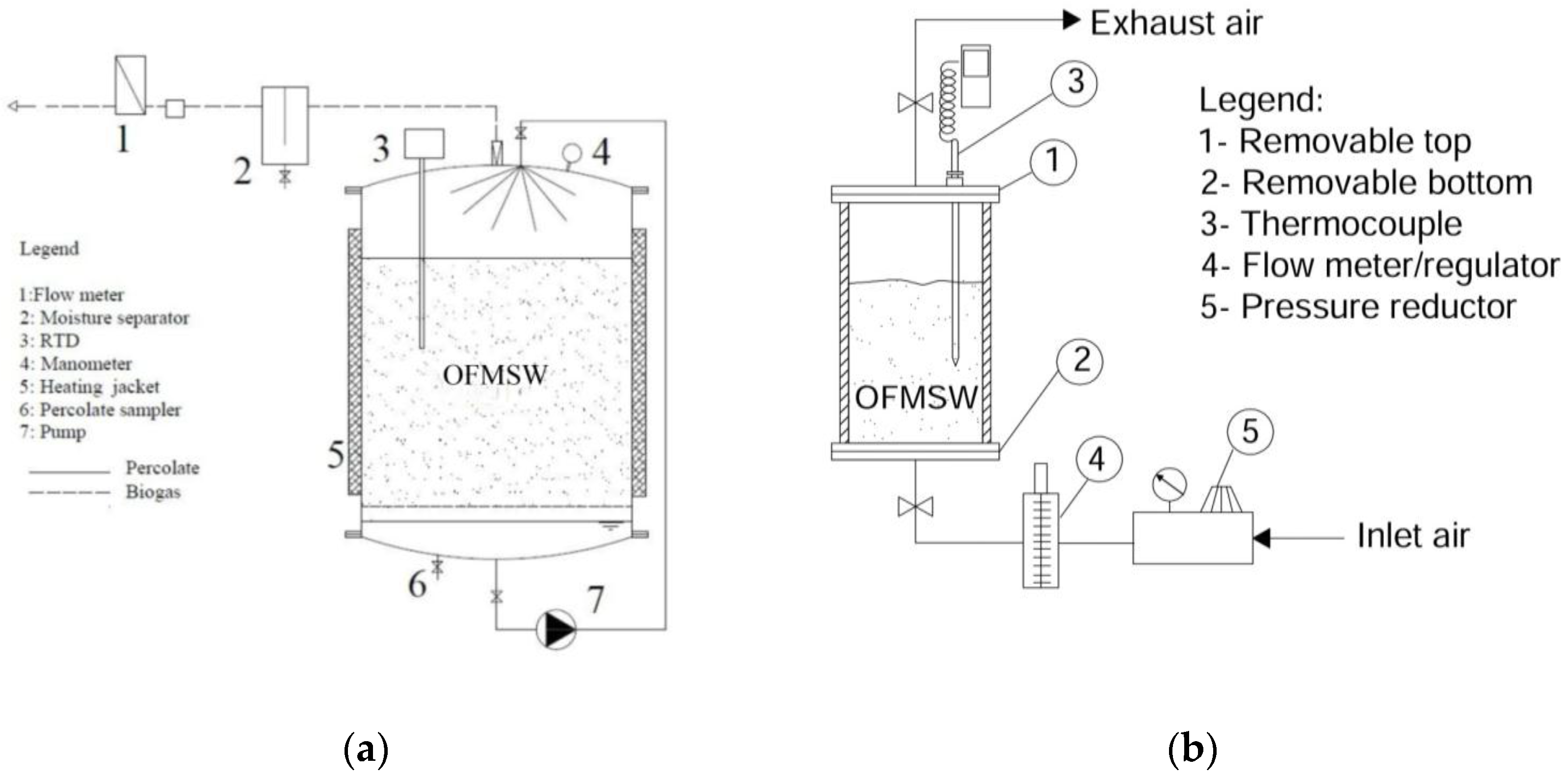
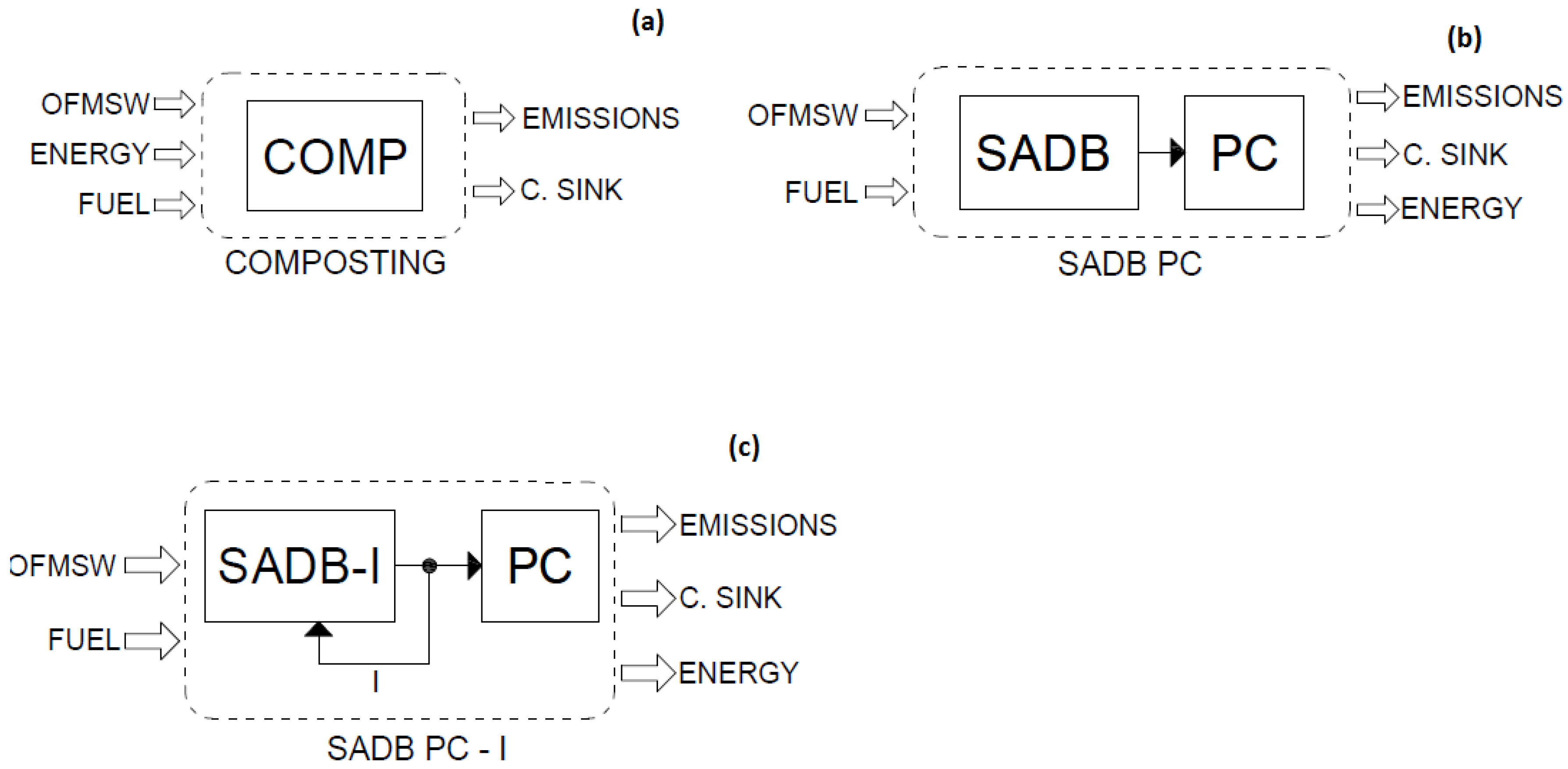
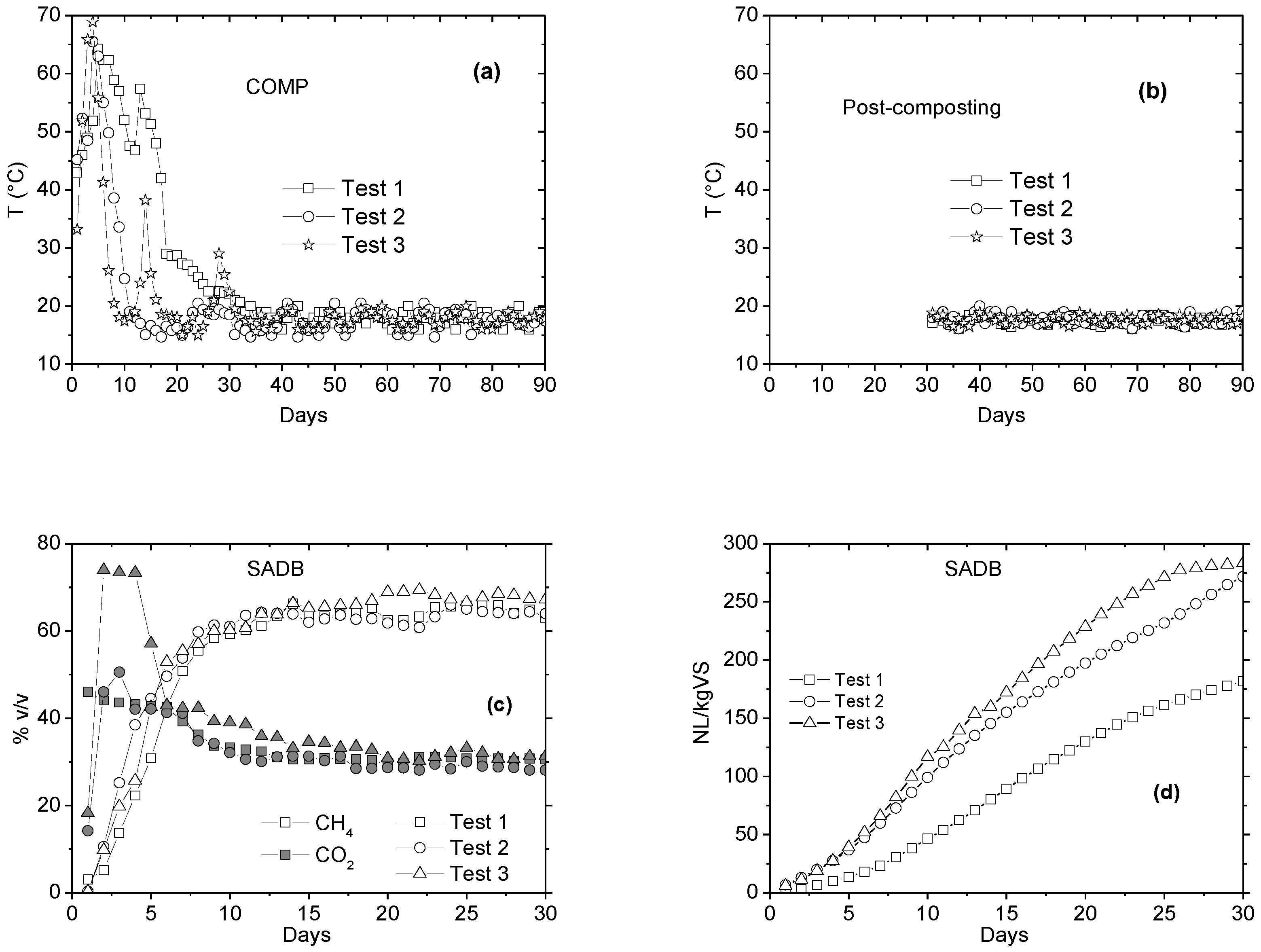

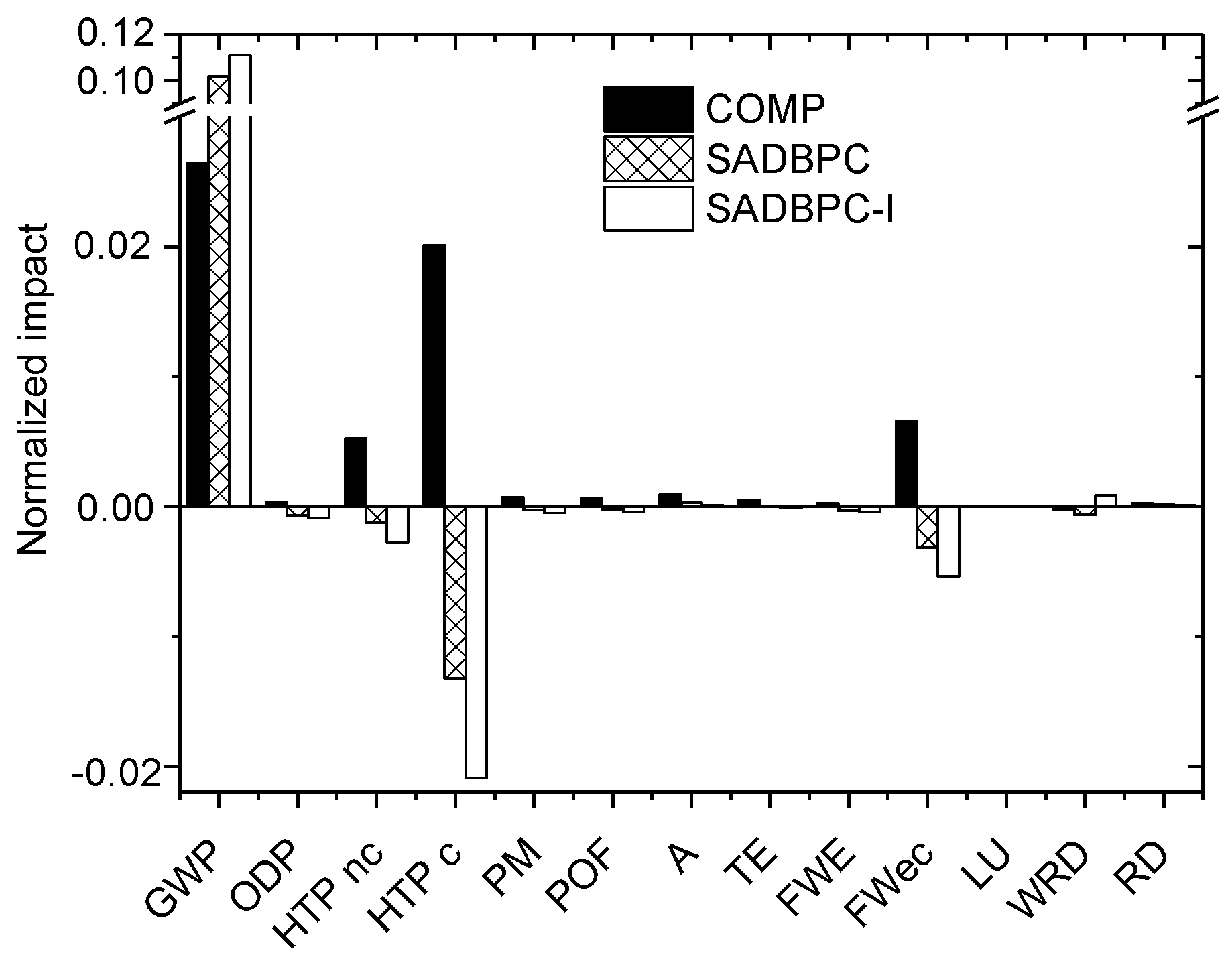

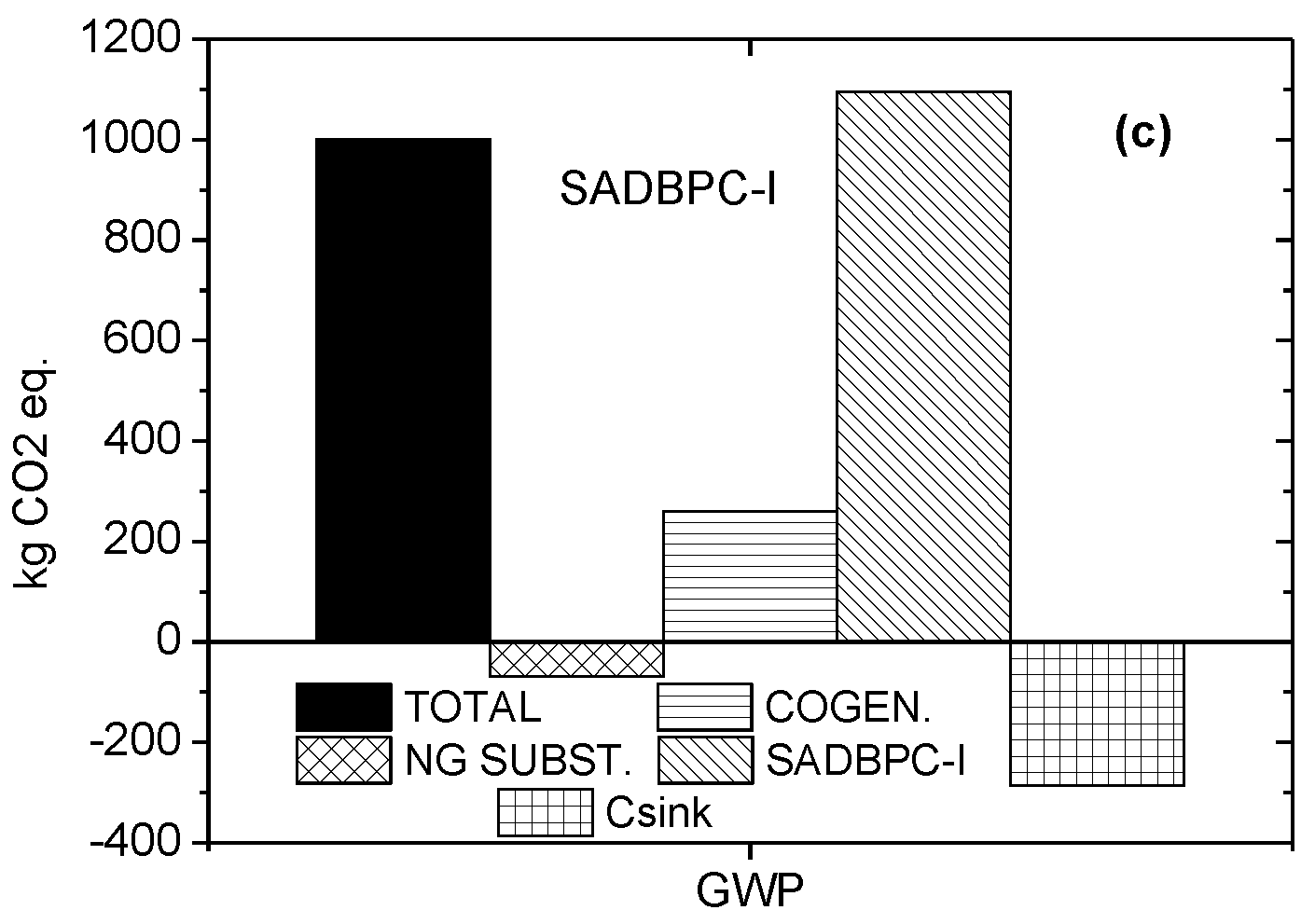
| Parameter | Composting/PC (g) | SADB (g) |
|---|---|---|
| NH3 | 0.978 | 0.203 |
| CO2 | 8.430 | - |
| CO2,bio | 520.0 | 579.2 |
| CO | 1.280 | 2.153 |
| N2O | 0.281 | 0.069 |
| H2S | 0.528 | 0.169 |
| CH4 | 10.10 | 5.897 |
| NOx | 0.453 | - |
| Parameter | Value |
|---|---|
| CO2,bio (kg) | 1.594 |
| CObio (mg) | 916.3 |
| N2O (mg) | 47.73 |
| CH4,bio (mg) | 916.3 |
| NOx (mg) | 285.4 |
| NMVOC (mg) | 38.17 |
| Pt (ng) | 133.6 |
| SO2 (mg) | 478.0 |
| Impact Category | Unit | Norm. f. EU27 (2010) | Unit |
|---|---|---|---|
| Global warming potential—GWP | kgCO2 eq. | 1.10 × 10−4 | kgCO2 eq./a. |
| Ozone depletion layer—ODP | kgCFC−11 eq. | 46.3 | kgCFC-11 eq./a. |
| Human toxicity, non-cancer effects—HTnc | CTUh | 1876 | CTUh |
| Human toxicity, cancer effects—HTc | CTUh | 27100 | CTUh |
| Particulate matter—PM | kgPM2.5 eq. | 2.63 × 10−1 | kgPM2.5 eq./a. |
| Photochemical ozone formation—POF | kgNMVOC eq. | 3.15 × 10−2 | kgNMVOC eq./a. |
| Acidification—A | molc H+ eq. | 2.11 × 10−2 | molc H+ eq./a. |
| Eutrophication terrestrial—ET | molc N eq. | 5.68 × 10−3 | molc. N eq./a. |
| Fresh water eutrophication—FWE | kg P eq. | 6.76 × 10−1 | kg P eq./a. |
| Fresh water ecotoxicity—FWec | CTUe | 1.14 × 10−4 | CTUe/a. |
| Water resource depletion—WRD | m3 water eq. | 1.23 × 10−2 | m3 water eq./a. |
| Min., foss. & ren. Res. Depletion—RD | kg Sb eq. | 9.9 | kg Sb eq./a. |
| Sample n | MC/σ2 (%w/w) | VS/σ2 (%TS) | TOC/σ2 (%TS) | TKN/σ2 (%TS) | HA + FA/σ2 (%TS) | TEC/σ2 (%TS) | pH/σ2 |
|---|---|---|---|---|---|---|---|
| 1 | 64.8/0.63 | 77.2/0.03 | 37.9/0.21 | 1.99/4 × 10−4 | 11.3/0.21 | 15.4/0.13 | 6.47/0.57 |
| 2 | 64.5/7.69 | 76.1/0.87 | 35.5/0.02 | 1.74/5 × 10−4 | 10.6/0.15 | 18.9/0.12 | 5.56/0.07 |
| 3 | 60.2/4.83 | 69.6/11.5 | 29.5/1.23 | 0.88/4.5 × 10−3 | 8.87/0.23 | 16.6/0.19 | 6.18/2E-3 |
| 4 | 61.9/12.1 | 67.8/1.93 | 30.2/1.43 | 1.05/5 × 10−3 | 8.35/0.11 | 14.5/0.21 | 6.69/7E-3 |
| 5 | 55.3/2.22 | 59.2/0.16 | 31.7/0.91 | 0.86/3 × 10−3 | 7.33/0.21 | 15.4/0.30 | 7.19/2E-4 |
| 6 | 48.7/2.67 | 73.6/5.63 | 33.2/0.82 | 1.53/3.4 × 10−3 | 10.0/0.18 | 18.3/0.33 | 5.81/0.01 |
| Test No. | Parameter | ||||||
|---|---|---|---|---|---|---|---|
| Amendment (after 90 days) | |||||||
| Treatment Scheme | TOC/σ2 (%TS) | TOCf/Mg a (g) | HA + FA/σ2 (%TS) | DH (%) | pH/σ2 | ||
| SADB not inoculated | |||||||
| 1 | COMP | 26.1/0.69 | 131 | 9.17/0.21 | 68.0 | 8.9/3 × 10−3 | |
| SADBPC | 30.3/0.55 | 156 | 10.5/0.16 | 69.8 | 8.5/6 × 10−3 | ||
| 2 | COMP | 23.7/3.81 | 123 | 10.8/0.14 | 77.3 | 8.7/0.05 | |
| SADBPC | 26.0/0.19 | 145 | 8.36/0.22 | 82.1 | 8.9/6 × 10−4 | ||
| 3 | COMP | 15.4/0.37 | 121 | 3.64/0.16 | 76.0 | 8.7/8 × 10−3 | |
| SADBPC | 15.5/0.02 | 147 | 6.12/0.19 | 92.6 | 8.9/1 × 10−3 | ||
| SADB inoculated | |||||||
| 4 | COMP | 23.1/0.19 | 128 | 7.25/0.02 | 80.8 | 9.6/2 × 10−3 | |
| SADBPC-I | 22.7/0.68 | 75.0 | 6.56/0.11 | 39.1 | 8.8/0.02 | ||
| 5 | COMP | 23.3/0.07 | 120 | 7.17/0.32 | 68.6 | 9.4/5 × 10−3 | |
| SADBPC-I | 21.1/0.42 | 107 | 6.07/0.24 | 64.8 | 9.4/2 × 10−3 | ||
| 6 | COMP | 24.5/0.52 | 147 | 5.30/0.01 | 98.7 | 9.2/2 × 10−3 | |
| SADBPC-I | 23.5/0.63 | 132 | 7.26/0.09 | 82.3 | 9.2/3 × 10−3 | ||
| Direct Emissions Variation (%) | −75% | −50% | −25% | 0 | +25% | +50% | +75% |
|---|---|---|---|---|---|---|---|
| GWP (kgCO2 eq) | |||||||
| Treatment scheme | |||||||
| COMP | −111.8 | 4.459 | 120.7 | 237.0 | 353.3 | 469.6 | 585.9 |
| SADBPC | 80.90 | 339.7 | 598.5 | 857.3 | 1116 | 1375 | 1634 |
| SADBPC−I | 176.8 | 451.5 | 726.1 | 1000 | 1275 | 1550 | 1824 |
© 2017 by the authors. Licensee MDPI, Basel, Switzerland. This article is an open access article distributed under the terms and conditions of the Creative Commons Attribution (CC BY) license (http://creativecommons.org/licenses/by/4.0/).
Share and Cite
Maria, F.D.; Sisani, F. Greenhouse Gas Emissions and Environmental Impact from Recycling the Organic Fraction of Solid Waste: Comparison of Different Treatment Schemes from a Life Cycle Perspective. Recycling 2017, 2, 13. https://doi.org/10.3390/recycling2030013
Maria FD, Sisani F. Greenhouse Gas Emissions and Environmental Impact from Recycling the Organic Fraction of Solid Waste: Comparison of Different Treatment Schemes from a Life Cycle Perspective. Recycling. 2017; 2(3):13. https://doi.org/10.3390/recycling2030013
Chicago/Turabian StyleMaria, Francesco Di, and Federico Sisani. 2017. "Greenhouse Gas Emissions and Environmental Impact from Recycling the Organic Fraction of Solid Waste: Comparison of Different Treatment Schemes from a Life Cycle Perspective" Recycling 2, no. 3: 13. https://doi.org/10.3390/recycling2030013





